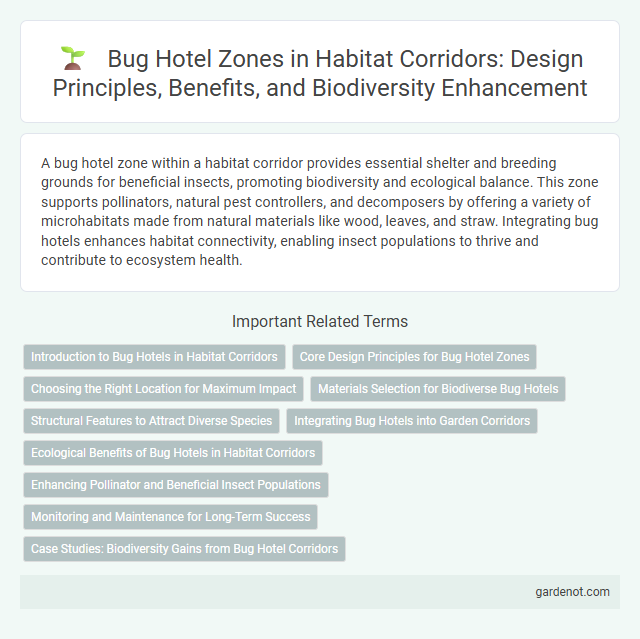A bug hotel zone within a habitat corridor provides essential shelter and breeding grounds for beneficial insects, promoting biodiversity and ecological balance. This zone supports pollinators, natural pest controllers, and decomposers by offering a variety of microhabitats made from natural materials like wood, leaves, and straw. Integrating bug hotels enhances habitat connectivity, enabling insect populations to thrive and contribute to ecosystem health.
Introduction to Bug Hotels in Habitat Corridors
Bug hotels in habitat corridors serve as essential microhabitats that support biodiversity by providing shelter, breeding sites, and foraging areas for beneficial insects like pollinators and pest controllers. These structures are designed using natural materials such as wood, bamboo, and straw, mimicking insect nesting preferences and enhancing ecosystem connectivity. Integrating bug hotels within habitat corridors helps sustain ecological balance, promotes species diversity, and improves overall habitat quality.
Core Design Principles for Bug Hotel Zones
Bug hotel zones should prioritize habitat diversity by incorporating a variety of natural materials such as wood, leaves, and hollow stems to attract different insect species. The design must ensure shelter from predators and extreme weather, providing stable microclimates for breeding and overwintering. Connectivity with surrounding habitats enhances ecological corridors, facilitating safe movement and genetic exchange among insect populations.
Choosing the Right Location for Maximum Impact
Selecting the optimal location for a bug hotel within a habitat corridor involves prioritizing areas with abundant native vegetation and pollen sources to attract diverse insect species. Placement near moist, shaded environments increases humidity levels conducive to insect habitation and reproduction. Ensuring proximity to natural predator shelters enhances ecological balance and supports pest control within the corridor.
Materials Selection for Biodiverse Bug Hotels
Selecting diverse natural materials such as untreated wood, bamboo, straw, dry leaves, and pine cones enhances the structural complexity of bug hotels, attracting a wide range of insect species. Using locally sourced, pesticide-free resources supports native biodiversity and ensures compatibility with the surrounding habitat corridor. Incorporating varying textures and sizes within the materials offers optimal nesting and sheltering opportunities for pollinators, decomposers, and other beneficial arthropods.
Structural Features to Attract Diverse Species
The bug hotel zone incorporates diverse structural features such as layered compartments filled with natural materials like wood, straw, and bark, providing essential habitats for a wide range of insect species. Hollow stems, drilled logs, and crevices create nesting and overwintering sites that enhance biodiversity within the habitat corridor. These intricate designs support pollinators, decomposers, and pest controllers, contributing to ecosystem balance and resilience.
Integrating Bug Hotels into Garden Corridors
Integrating bug hotels into garden corridors enhances biodiversity by providing essential habitats for pollinators and beneficial insects. These structures support natural pest control and improve plant health, boosting the overall ecosystem resilience. Strategically placing bug hotels within habitat corridors connects isolated green spaces, facilitating insect movement and genetic exchange.
Ecological Benefits of Bug Hotels in Habitat Corridors
Bug hotels in habitat corridors provide essential microhabitats that support biodiversity by offering shelter and breeding grounds for pollinators, decomposers, and predatory insects. These structures enhance pest control through natural predator populations and contribute to soil health by promoting nutrient cycling. Integrating bug hotels within habitat corridors strengthens ecosystem resilience and connectivity, facilitating species movement and genetic exchange.
Enhancing Pollinator and Beneficial Insect Populations
Bug hotel zones provide essential habitats that support the diversity and abundance of pollinators and beneficial insects crucial for ecosystem health. Designed with varied materials like wood, hollow stems, and dried leaves, these structures offer shelter, breeding sites, and protection from predators. Enhancing pollinator populations through bug hotels directly improves plant pollination rates and agricultural productivity.
Monitoring and Maintenance for Long-Term Success
Regular monitoring of the Bug Hotel Zone is essential to assess insect diversity and habitat health, utilizing periodic surveys and sensor data to track occupancy and environmental conditions. Maintenance activities include removing debris, repairing structural elements, and replenishing nesting materials to ensure optimal shelter quality and functionality. Consistent evaluation and adaptive management strategies help sustain the corridor's ecological connectivity and enhance biodiversity conservation over time.
Case Studies: Biodiversity Gains from Bug Hotel Corridors
Bug hotel corridors create essential refuges for pollinators and beneficial insects, boosting local biodiversity by providing shelter and breeding grounds. Case studies reveal significant increases in insect populations and species diversity, enhancing ecosystem services like pollination and pest control. These corridors contribute to landscape connectivity, allowing species to migrate safely and maintain genetic diversity.
Bug hotel zone Infographic

 gardenot.com
gardenot.com